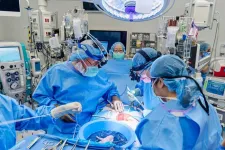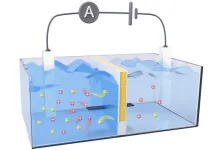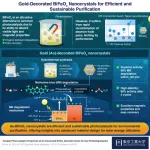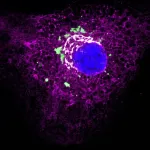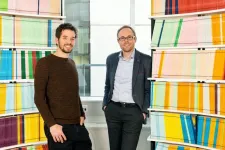(Press-News.org) NEW YORK, NY, APRIL 24, 2024— Surgeons at NYU Langone Health performed the first-ever combined mechanical heart pump and gene-edited pig kidney transplant surgery in a 54-year-old woman with heart and kidney failure—a confluence of advances that showcase the possibility and hope of modern medicine.
Doctors performed this feat in two stages: first surgically implanting the heart pump days before embarking on the landmark transplant, which included a gene-edited pig kidney and the pig’s thymus gland to aid against rejection. Before the procedure, patient Lisa Pisano, a New Jersey native, faced heart failure and end-stage kidney disease that required routine dialysis. She was not a candidate for heart and kidney transplants because several chronic medical conditions significantly reduced the likelihood of a good outcome and there aren’t enough organs for those in need.
Despite these adversities, Pisano has thrived from the love of her grandchildren and eagerly wants to watch them grow up.
“All I want is the opportunity to have a better life,” she said. “After I was ruled out for a human transplant, I learned I didn’t have a lot of time left. My doctors thought there may be a chance I could be approved to receive a gene-edited pig kidney, so I discussed it with my family and my husband. He has been by my side throughout this ordeal and wants me to be better.”
To date, there have been no documented instances of anyone with a mechanical heart pump receiving an organ transplant of any kind. It is only the second known transplant of a gene-edited pig kidney into a living person, and the first with the thymus combined.
“It is incredible to consider the scientific achievements that have led to our ability to save Lisa’s life, and what we are endeavoring to do as a society for everyone in need of a life-saving organ,” said Robert Montgomery, MD, DPhil, who led the transplant surgery and who is the H. Leon Pachter, MD, Professor of Surgery; chair of the Department of Surgery; and director of the NYU Langone Transplant Institute. “This could not have been done without the dedication and skill of the many talented physicians, researchers, nurses, health administrators, and perioperative care teams at NYU Langone Health, and the numerous pioneers who came before us.”
Nearly 104,000 people are on the waiting list for a transplant, with 89,360 of those waiting for a kidney. Nearly 808,000 people in the United States have end-stage kidney disease but only about 27,000 were able to receive a transplant last year.
Multimedia Materials Available
Multimedia materials, including photos and a B-roll package, are available for download.
About the Procedures
The series of procedures were performed by two separate surgical teams over the course of nine days.
In the first procedure, surgeons implanted the heart pump, a device called a left ventricular assist device (LVAD), which is typically used in patients who are awaiting heart transplantation or otherwise ruled ineligible to receive a heart transplant.
Without a heart pump Pisano’s life expectancy would have been measured in days or weeks.
Nader Moazami, MD, chief of the Division of Heart and Lung Transplantation and Mechanical Circulatory Support for the Department of Cardiothoracic Surgery at NYU Grossman School of Medicine, and Deane E. Smith, MD, director of mechanical circulatory support, performed the LVAD surgery on April 4, 2024, in NYU Langone’s Kimmel Pavilion in New York.
The second procedure was a xenotransplant, which is a transplant of an organ between different species. Dr. Montgomery led the xenotransplant on April 12, 2024.
Pisano had high levels of harmful antibody to human tissue, but not to gene-edited pig organs. It would have taken years for her to find a match for a human kidney transplant. Dr. Montgomery approached United Therapeutics Corporation and determined an investigational gene-edited pig kidney with thymus was available and matched. Although chronic kidney failure typically rules patients out from receiving an LVAD, the hope of the transplant preventing her from needing dialysis was a key consideration.
“Without the possibility of a kidney transplant, she would not have been eligible as a candidate for an LVAD due to the high mortality in patients on dialysis with heart pumps,” said Dr. Moazami. “This unique approach is the first time in the world that LVAD surgery has been done on a dialysis patient with a subsequent plan to transplant a kidney. The measure for success is a chance at a better quality of life and to give Lisa more time to spend with her family.”
Pisano received the organ from a pig genetically engineered to disrupt, or “knock out,” the gene responsible for the production of a sugar known as alpha-gal. In previous studies at NYU Langone, it was demonstrated that removing alpha-gal was sufficient to prevent an antibody reaction that can cause immediate, or hyperacute, rejection of the xeno-organ. The donor pig’s thymus gland, which is responsible for educating the immune system, was surgically placed under the covering of the kidney to reduce the likelihood of rejection. The xenokidney and the thymus tissue combined are called a UThymoKidney™. The gene edits, pig breeding, and production of the investigational UThymoKidney™ used in this procedure were performed by United Therapeutics Corporation. No other unapproved devices or medications were used in the procedure.
“By using pigs with a single genetic modification, we can better understand the role one key stable change in the genome can have in making xenotransplantation a viable alternative,” said Dr. Montgomery. “Since these pigs can be bred and do not require cloning like more-complex gene edits, this is a sustainable, scalable solution to the organ shortage. If we want to start saving more lives quickly, using fewer modifications and medications will be the answer.”
The effort required rigorous preparation, clearance by NYU Langone’s institutional review board, and approval by the FDA through its Expanded Access Program—sometimes called “compassionate use” and meant for patients who have a serious or immediately life-threatening condition.
Additional investigators in the xenotransplant included Adam Griesemer, MD; Jeffrey M. Stern, MD; Bonnie E. Lonze, MD, PhD; Nicole M. Ali, MD; Sapna A. Mehta, MD; Vasishta Tatapudi, MD; Massimo Mangiola, PhD; Elaina Weldon, MSN, NP; Karen Khalil, PharmD; Jacqueline Kim, MD; Ian S. Jaffe; Imad Aljabban, MD; Aprajita Mattoo, MD; Rebecca Esker, PharmD; Nikki Lawson, RN; Jef Boeke, PhD; Brendan Keating, PhD; and Alexandre Loupy, MD, PhD, director of the Paris Institute for Transplant and Organ Regeneration.
The NYU Langone Transplant Institute collaborated with David Sachs, MD, and Megan Sykes, PhD, of the Columbia Center for Translational Immunology (CCTI) at Columbia University Irving Medical Center. They both helped to develop a pig thymus–kidney concept with the intent of reducing the amount of immunosuppression. This procedure marked the first-ever human transplant of a pig-derived thymokidney.
NYU Langone Health acknowledges United Therapeutics Corporation for the UThymoKidney™ and financial support provided for xenotransplantation research initiatives and this procedure, as well as the support of Apellis Pharmaceuticals Inc.’s Compassionate Use Program, which provided Empaveli®, also known as pegcetacoplan, a medicine used in the off-label treatment to prevent rejection of the organ.
Progress in Xenotransplantation
This complex intervention marks the sixth human xenotransplant surgery performed by the NYU Langone Transplant Institute and orchestrated by Dr. Montgomery, who has spent much of his career studying innovative approaches to expanding the organ supply and performed the world’s first gene-edited pig-to-human organ transplant on September 25, 2021, in a neurologically deceased person with a beating heart. The same gene-edited pig kidney and thymus were used in that procedure and in a second similar procedure on November 22, 2021. Surgeons at NYU Langone then performed two gene-edited pig heart transplants in summer 2022. Last year, a 61-day study of a gene-edited pig kidney xenotransplant in a recently deceased man showed optimal performance with standard-of-care immunosuppression.
The NYU Langone Transplant Institute has performed more xenotransplantation surgeries in humans than any other institution to date. Before this most recent surgery, however, five were done using a special protocol involving recently deceased people, in collaboration with their families, to study the effectiveness and viability of gene-edited pig organs in humans before transplanting them into living people.
“Without the generosity and altruism of those who participated in our series of decedent model studies, this moment in transplantation would not have been possible,” said Dr. Montgomery. “We eagerly await the opportunity to participate in clinical trials, under the FDA’s guidance, to continue learning more about the possibility of a new, sustainable source of organs for all those without much time left.”
About the NYU Langone Transplant Institute
The NYU Langone Transplant Institute offers the highest-quality kidney and lung transplantation programs in the nation, according to federal quality data, while the heart and liver transplant programs stand out in national survival rates and in their success getting patients off the waitlist. In 2023, the institute performed 576 organ transplants. NYU Langone’s heart, kidney, liver, lung, and pancreas transplant programs are approved by the Centers for Medicare & Medicaid Service (CMS), which means they have met the stringent volume, process, quality, and survival outcome requirements of CMS regulation.
Media Inquiries
Colin DeVries
Phone: 212-404-3588
Colin.DeVries@NYULangone.org
END
First-ever combined heart pump and pig kidney transplant gives new hope to patient with terminal illness
2024-04-24
ELSE PRESS RELEASES FROM THIS DATE:
FAU receives grant to examine role of pet dogs on military adolescents
2024-04-24
Florida Atlantic University Christine E. Lynn College of Nursing’s Canines Providing Assistance to Wounded Warriors (C-P.A.W.W.) has received a new grant from the Human Animal Bond Research Institute (HABRI) for research that investigates the contribution of pet dog ownership to resilience and well-being in adolescent children of military families.
The grant was awarded to a team of researchers led by Laurie Martinez, Ph.D., an assistant professor, FAU College of Nursing; and co-led by Cheryl A. Krause-Parello, Ph.D., associate vice president for research, FAU Division of Research and a research professor in the College of Nursing.
This important study will provide ...
COVID-19 pandemic alters view that doctors are obligated to provide care
2024-04-24
DURHAM, N.C. – The unique circumstances arising from the COVID-19 pandemic altered a long-held convention that doctors provide care regardless of personal risk.
In a study assessing doctors’ tolerance for refusing care to COVID-19 patients, Duke Health researchers identified a growing acceptance to withhold care because of safety concerns.
“All the papers throughout history have shown that physicians broadly believed they should treat infectious disease patients,” said the study’s lead author, Braylee Grisel, a fourth-year student at Duke University ...
This salt battery harvests osmotic energy where the river meets the sea
2024-04-24
Estuaries — where freshwater rivers meet the salty sea — are great locations for birdwatching and kayaking. In these areas, waters containing different salt concentrations mix and may be sources of sustainable, “blue” osmotic energy. Researchers in ACS Energy Letters report creating a semipermeable membrane that harvests osmotic energy from salt gradients and converts it to electricity. The new design had an output power density more than two times higher than commercial membranes in lab demonstrations.
Osmotic energy can be generated anywhere salt gradients are ...
On the trail of deepfakes, Drexel researchers identify ‘fingerprints’ of AI-generated video
2024-04-24
In February, OpenAI released videos created by its generative artificial intelligence program Sora. The strikingly realistic content, produced via simple text prompts, is the latest breakthrough for companies demonstrating the capabilities of AI technology. It also raised concerns about generative AI’s potential to enable the creation of misleading and deceiving content on a massive scale. According to new research from Drexel University, current methods for detecting manipulated digital media will not be effective against AI-generated video; but a machine-learning approach could be the key to unmasking these synthetic creations.
In a paper accepted ...
Virtual reality can motivate people to donate to refugee crises regardless of politics
2024-04-24
PULLMAN, Wash. – Political conservatives who watched a documentary on Syrian refugees with a virtual reality headset had far more sympathy for the people depicted in the film than those who viewed the same film on a two-dimensional computer screen.
Higher sympathy levels among the conservatives who watched the VR version of the documentary, “Clouds over Sidra,” resulted in a greater willingness to donate to the crisis, according to a study on the research published in New Media & Society.
Liberal participants in the study reported high levels of sympathy and ...
Holographic displays offer a glimpse into an immersive future
2024-04-24
Setting the stage for a new era of immersive displays, researchers are one step closer to mixing the real and virtual worlds in an ordinary pair of eyeglasses using high-definition 3D holographic images, according to a study led by Princeton University researchers.
Holographic images have real depth because they are three dimensional, whereas monitors merely simulate depth on a 2D screen. Because we see in three dimensions, holographic images could be integrated seamlessly into our normal view of the everyday world.
The result is a virtual and augmented reality display that has the potential to be truly immersive, the kind where you can move your head ...
Novel Au-BiFeO3 nanostructures for efficient and sustainable degradation of pollutants
2024-04-24
The need for sustainable and environment-friendly solutions has accelerated the global demand for green and renewable technologies. In this regard, semiconductor photocatalysts have emerged as an attractive solution, owing to their potential in mitigating pollutants and harnessing solar energy efficiently. Photocatalysts are materials that initiate chemical reactions when exposed to light. Despite their progress, commonly used photocatalysts suffer from reduced photocatalytic activity and a narrow operation range within the visible ...
It takes two to TANGO: New strategy to tackle fibrosis and scarring
2024-04-24
Researchers at the Centre for Genomic Regulation in Barcelona and the University of Cologne in Germany have developed a new experimental strategy to tackle scarring and fibrosis. Experiments with patient-derived human cells and animal models showed the strategy was effective, non-toxic and its effects reversible. The findings are published today in the journal Nature Communications.
Scarring occurs from the secretion and accumulation of various components – primarily proteins known as collagens – into the space between individual cells, usually occurring as a response to injury or damage. Excessive collagen secretion can also cause the buildup of fibrotic ...
Researchers aim to analyze pangenomes using quantum computing
2024-04-24
A new collaboration brings together a world-leading interdisciplinary team with skills across quantum computing, genomics, and advanced algorithms. They aim to tackle one of the most challenging computational problems in genomic science: building, augmenting and analysing pangenomic datasets for large population samples. Their project sits at frontiers of research in both biomedical science and quantum computing.
The project, which involves researchers based at the University of Cambridge, the Wellcome Sanger Institute and EMBL’s European ...
Ready and vigilant: immune cells on standby
2024-04-24
When pathogens invade the body, the immune system must react immediately to prevent or contain an infection. But how do our defence cells stay ready when no attacker is in sight? Scientists from Vienna have found a surprising explanation: They are constantly stimulated by healthy tissue. This keeps them active and ready to respond to pathogens. Based on this insight, future medications could be devised to selectively enhance our immune system’s attention. The study has been published in the journal Nature Immunology (DOI: 10.1038/s41590-024-01804-1).
Communication is crucial in immune defence. When ...
